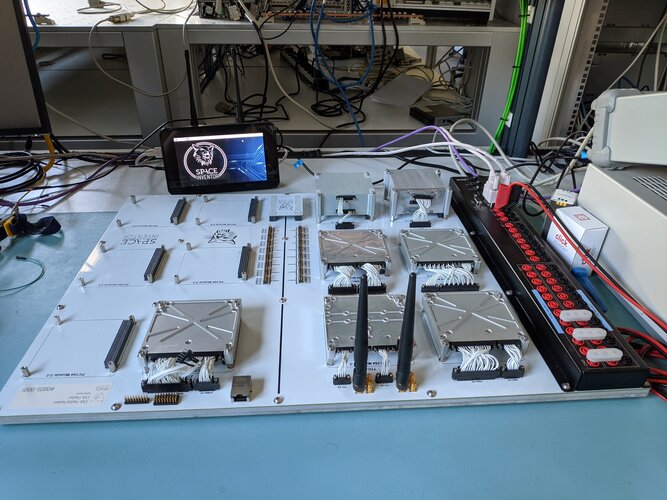
Copernical Team
Studying the edge of the sun's magnetic bubble

Our corner of the universe, the solar system, is nestled inside the Milky Way galaxy, home to more than 100 billion stars. The solar system is encased in a bubble called the heliosphere, which separates us from the vast galaxy beyond—and some of its harsh space radiation.
We're protected from that radiation by the heliosphere, which itself is created by another source of radiation: the sun. The sun constantly spews charged particles, called the solar wind, from its surface. The solar wind flings out to about four times the distance of Neptune, carrying with it the magnetic field from the sun.
Image: Auroras viewed from orbit

Auroras make for great Halloween décor over Earth, though ESA astronaut Thomas Pesquet snapped these green smoky swirls of plasma from the International Space Station in August. Also pictured are the Soyuz MS-18 "Yuri Gagarin" (left) and the new Nauka module (right).
The Station saw quite some aurora activity that month, caused by solar particles colliding with Earth's atmosphere and producing a stunning light show.
Fast forward to October and space is quite busy.
On 9 October the sun ejected a violent mass of fast-moving plasma into space that arrived at Earth a few days later. The coronal mass ejection (CME) crashed into our planet's magnetosphere and once again lit up the sky.
CMEs explode from the sun, rush through the solar system and while doing so speed up the solar wind—a stream of charged particles continuously released from the sun's upper atmosphere.
While most of the solar wind is blocked by Earth's protective magnetosphere, some charged particles become trapped in Earth's magnetic field and flow down to the geomagnetic poles, colliding with the upper atmosphere to create the beautiful Aurora.
Meet the winners of two ESA competitions at the IAC 2021

Ten start-up companies and SMEs secured the top places in ESA’s 2020 start-up competition and the Agency’s 2021 Global Space Markets Challenge.
Opened-out ‘FlatSat’ for CubeSat testing

ESA’s latest CubeSat mission is destined to never leave the ground. Instead it is doing its duty as an opened-out ‘FlatSat’ – with its interlinked subsystems spread out across a table at the Agency’s Data Systems and Microelectronics Laboratory at its ESTEC technical centre in the Netherlands.
Dwarf galaxy catches globular cluster
 Astronomers already knew that our own Milky Way grew by taking in smaller galaxies. But now a team of Italian-Dutch researchers have shown that a small galaxy neighbouring the Milky Way has in turn absorbed an even smaller galaxy from its vicinity. The researchers will publish their findings on Monday in the journal Nature Astronomy.
According to the prevailing theory, large galaxies such
Astronomers already knew that our own Milky Way grew by taking in smaller galaxies. But now a team of Italian-Dutch researchers have shown that a small galaxy neighbouring the Milky Way has in turn absorbed an even smaller galaxy from its vicinity. The researchers will publish their findings on Monday in the journal Nature Astronomy.
According to the prevailing theory, large galaxies such Astronomers see white dwarf switch on and off
 White dwarfs are what most stars become after burning off the hydrogen that fuels them. Now our astronomers have seen one of these galactic objects switching on and off for the first time.
Researchers used a planet-hunting satellite to observe the unique phenomenon in a white dwarf about 1,400 light years from Earth.
This particular white dwarf is known to be accreting, or feeding, f
White dwarfs are what most stars become after burning off the hydrogen that fuels them. Now our astronomers have seen one of these galactic objects switching on and off for the first time.
Researchers used a planet-hunting satellite to observe the unique phenomenon in a white dwarf about 1,400 light years from Earth.
This particular white dwarf is known to be accreting, or feeding, f Researchers call for armchair astronomers to help find unknown hidden worlds
 Astronomers at Queen's University Belfast have launched a new online initiative, calling for volunteers to come forward and help to search for extrasolar planets.
The online citizen project, hosted by Zooniverse.org, Planet Hunters Next-Generation Transit Search (NGTS), is enlisting the help of the public to examine five years' worth of digital footage showing some of the brightest stars i
Astronomers at Queen's University Belfast have launched a new online initiative, calling for volunteers to come forward and help to search for extrasolar planets.
The online citizen project, hosted by Zooniverse.org, Planet Hunters Next-Generation Transit Search (NGTS), is enlisting the help of the public to examine five years' worth of digital footage showing some of the brightest stars i Hear sounds from Mars captured by Perseverance Rover
 Thanks to two microphones aboard NASA's Perseverance rover, the mission has recorded nearly five hours of Martian wind gusts, rover wheels crunching over gravel, and motors whirring as the spacecraft moves its arm. These sounds allow scientists and engineers to experience the Red Planet in new ways - and everyone is invited to listen in.
"It's like you're really standing there," said Bapti
Thanks to two microphones aboard NASA's Perseverance rover, the mission has recorded nearly five hours of Martian wind gusts, rover wheels crunching over gravel, and motors whirring as the spacecraft moves its arm. These sounds allow scientists and engineers to experience the Red Planet in new ways - and everyone is invited to listen in.
"It's like you're really standing there," said Bapti Uncovering the secrets of ultra-low frequency gravitational waves
 New methods of detecting ultra-low frequency gravitational waves can be combined with other, less sensitive measurements to deliver fresh insights into the early development of our universe, according to researchers at the University of Birmingham.
Gravitational waves - ripples in the fabric of Einstein's spacetime - that cross the universe at the speed of light have all sorts of wavelengt
New methods of detecting ultra-low frequency gravitational waves can be combined with other, less sensitive measurements to deliver fresh insights into the early development of our universe, according to researchers at the University of Birmingham.
Gravitational waves - ripples in the fabric of Einstein's spacetime - that cross the universe at the speed of light have all sorts of wavelengt White House declines comment on China hypersonic missile test
 White House Press Secretary Jen Psaki on Monday declined to comment on a report claiming that China tested a nuclear-capable hypersonic missile in August.
"I'm not going to comment on the specific report," Psaki said when asked if she could confirm the report that China tested a nuclear-capable hypersonic missile this summer that surprised US officials.
Psaki reiterated Defense Secre
White House Press Secretary Jen Psaki on Monday declined to comment on a report claiming that China tested a nuclear-capable hypersonic missile in August.
"I'm not going to comment on the specific report," Psaki said when asked if she could confirm the report that China tested a nuclear-capable hypersonic missile this summer that surprised US officials.
Psaki reiterated Defense Secre 